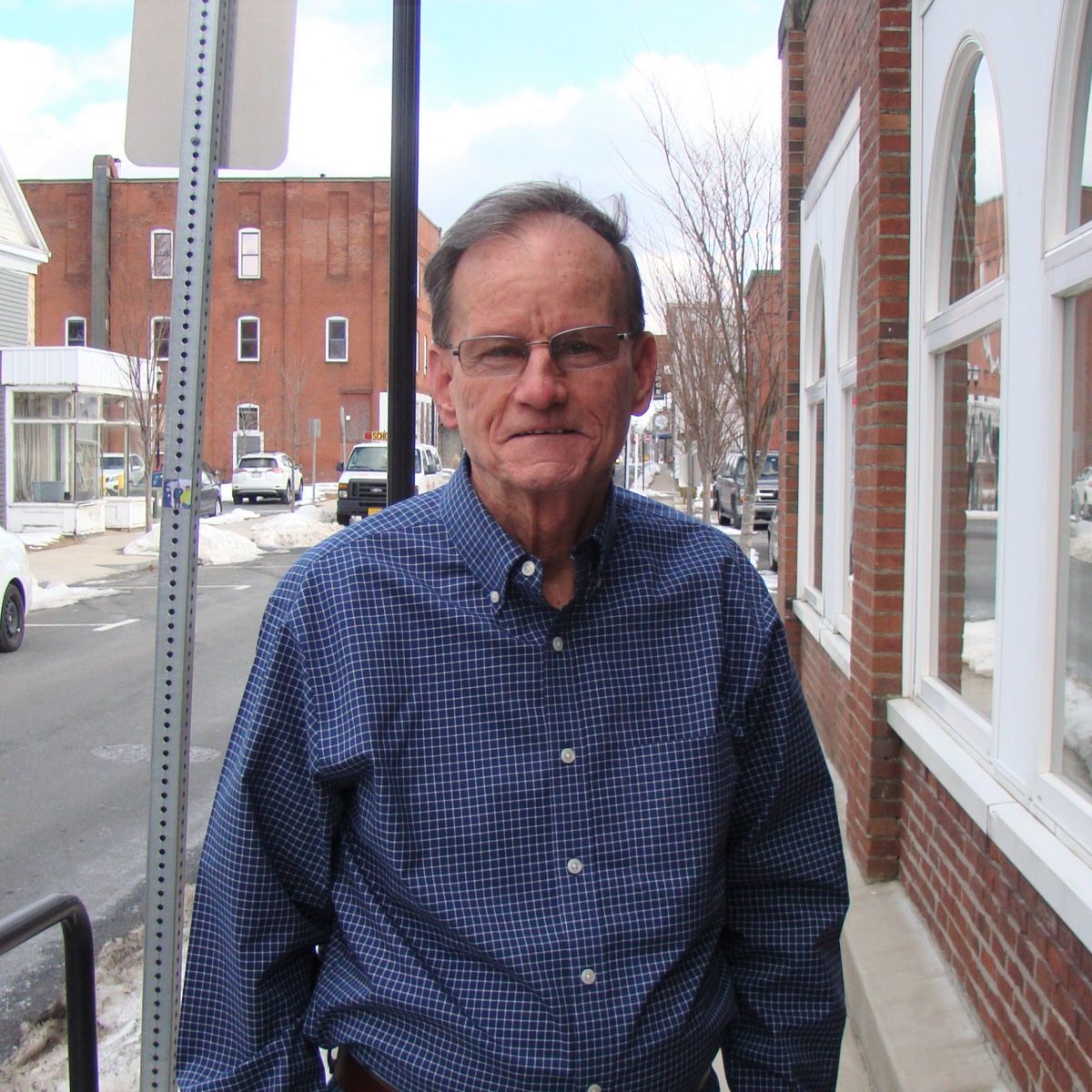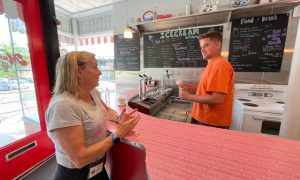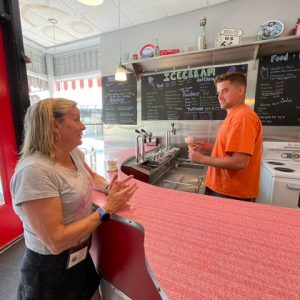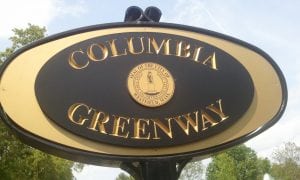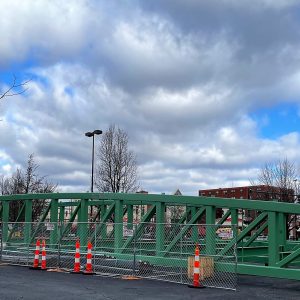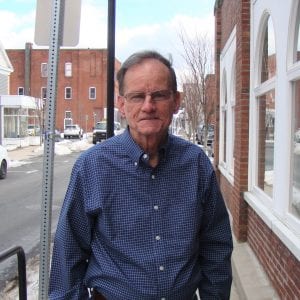
Friends of the Columbia Greenway Rail Trail member Daniel Call. (Photo by Amy Porter)
WESTFIELD – When Daniel Call checked on the progress of the Columbia Greenway Rail Trail project on the MassDOT website earlier this month and saw it listed at 100% design completion, he got excited.
“To me, that’s 23 years,” Call said, referring to his first involvement with the idea of a Rail Trail in 1996.
At the time, Call was chairman of the Open Space Committee. He said it was a sizable group of 10 to 12 members, charged with writing a five-year open space plan for the city.
Call, who grew up in Westfield and started his family here, said he always had in mind some kind of trail for the old rail bed that goes through Westfield.
Back then, rail trails were already gaining popularity across the country. Money was being dispersed through the T21 Fast Track program of the Federal Highway Administration, to be used for off road pedestrian shared paths.
“It started to catch on in 1996-97. We had a serious conversation about the Rail Trail, as a place to bike and walk, for roller blading, jogging, snowshoeing, cross-country skiing,” Call said. He said people would ask if it could be used year round. “Why can’t you? We advocate for that,” he said.
Call said the first trails in the area were the Norwottuck trail in Easthampton, and the Northampton Rail Trail, which opened in 2001. That same year, Westfield Mayor Richard K. Sullivan, Jr. appointed Call to chair an advisory committee for one in Westfield, after the city purchased the former Pioneer Valley Rail line.
In 2005, Call’s work on the Columbia Greenway Rail Trail was interrupted when he and his family moved to Southwick for ten years. While there he continued the work, helping with Southwick’s Rail Trail project. He also worked on ADA upgrades on the town beach, and helped to negotiate with the owner of Whalley Park to create the first park in Southwick, he said.
“I never forgot Westfield and the Columbia Greenway Rail Trail,” Call said. When he returned to Westfield in 2015, he joined the Friends of the Columbia Greenway Rail Trail, headed by chair Joseph Giffune and vice chair Carmel Steger.
Call said one of his jobs was working on maintenance job descriptions for people they would hire to help keep the trail clean, a particular focus of his.
“We get excited about a new idea, then others come along. You hold a Grand Opening. You mention maintenance, and where did everybody go? I am a big fan of that being a part of the process,” Call said.
He said now several volunteers of the FOCGRT work with the Department of Public Works and the Westfield Police Department to keep an eye on the trail.
Call returned to Westfield just as work on the central downtown portion of the Rail Trail was slated to begin in 2016. The funding was available from the Transportation Improvement Program at the time, but then he said in August of that year, the money was pushed out. “Gone,” he said.
Call said Westfield’s project, one of many in the 42 communities under the Transportation Committee of the MassDOT and Pioneer Valley Planning Commission, probably got pushed off because MassDOT said Westfield wasn’t ready.
For Westfield, it was all about the design work on the downtown portion that wasn’t finished. The Rail Trail is on the top of the railroad bed; but what came into play in the central section were the five bridges, and what to do about them.
“We could have focused just on the rail trail. What makes it unique is we looked at all five bridges,” Call said.
The central section of the trail will now have five bridges. The Gateway bridge on Main St., which was the first to come down, will be replaced. There will also be replacement bridges erected on Thomas St. and Chapel St. A complete historic renovation of the Elm St. bridge is a part of the project, along with another replacement bridge on Orange St.
Call said they also considered the height of the bridges, several of which had experienced trucks getting stuck under them. He said they reflected back on the Great River Bridge project, which raised the viaduct. They now plan to raise all five bridges to 14’6” clearance to accommodate the truck traffic.
“It was always the consideration about the bridges. In the 23 years, bridges took up 80% of the time,” Call said.
There were also cost considerations; and whether to take the bridges down to grade, which would have brought Rail Trail traffic across Main St., interspersing people and vehicles.
“I love the bridges,” Call said. He said there will now be zero possibility of conflict, and added, “For safety reasons, it was one of the best things we could do.”
The group also considered access to the community. He said there is access from the street to the trail at Stop & Shop. In the new section, there will be access from the Thomas St. bridge to the sidewalk. At Chapel St., behind the Westfield Savings Bank and Mobil Gas Station, there will be an access walkway down to grade at Elm St. Call said altogether in the half mile central section, there will be three access points.
He said at the end of the railroad bridge, which was completed last year, Rail Trail users can also take a right onto Elm St. or come out at the Women’s Temperance Park.
“We have really taken a hard look at accommodations,” Call said. He said with access to the downtown area, people can walk around, go to the park, for a sandwich, ice cream or soda. “This is the most congested area of the trail,” he said.
Call said a lot of different communities in a lot of different locations have benefited from the traffic from Rail Trails, bringing families downtown to spend money. He said there have been indepth studies on that kind of activity.
“Yes, we should go out of our way to make it appealing to come to Westfield. We’re going to get people that don’t live in Westfield coming to Westfield,” he said, adding that once the downtown section is finished, there will be more emphasis and thought on marketing the attractions, including brochures and kiosks. He said people from CT and RI can’t wait to come to the downtown area of Westfield.
Call said at the last Transportation Committee meeting at PVPC, two communities were on the agenda; and Westfield was one of them. Call gave the report.
The 100% design package completed by VHB (Vanesse Hangen Brustlin Inc.) was received by the MassDOT on Jan. 15. City Engineer Mark Cressotti said they are waiting on comments from MassDOT on design.
Cressotti said there will be several bid documents, because the bridges got separated from the Rail Trail, and the rehabilitation of the Elm St. bridge is separated.
“We are moving along on schedule,” Cressotti said. The city is in the middle of appraisal for four permanent and seven temporary easements along the access points to the trail, which is the city’s responsibility. He said they expect to be going to the City Council for eminent domain takings at the beginning of March. Cressotti has met with the property owners, and said there are no significant or controversial issues.
Call said at one point in time, people didn’t think much of the economics of the project. The cost on the central downtown section has increased, and is now $7,408,950, up from an earlier estimate of $6.6 million. Call said 80% will be covered by the federal government, and 20% by the state. He said people need to know once the funding is approved for a project, that money can’t be used for anything else.
The non-participating costs, such as the easements, are the city’s responsibility. To date, the Community Preservation Commission has given two grants of $250,000 to pay for the city’s portion.
Cressotti said they may be going back to the CPC in March for a third grant, but the city is also working on alternative funding by Gateway Community Grants. “You don’t get anything in concrete until you get the grant. Since it’s for the next fiscal year, we won’t hear until June,” said Cressotti. He said the CPC funding would be a backup, just in case.
Call said the target is to have everything in place and hand off the project to the MassDOT by the end of June, and the central portion is expected to be completed by 2020.
“For me, it’s been a pleasure working with the Friends of the Columbia Greenway Rail Trail,” Call said. He said they have worked with City Hall, the Mayor’s office, the City Council, Engineering, Department of Public Works and the Community Preservation Committee.
“We went through a few difficult times, but you have to keep moving. If a problem comes up, you don’t walk away, you fix the problem. There’s a light at the end of the tunnel; it’s more of a reality now,” Call said, adding that they all wondered at times if it would ever really happen.
“It was a lot of work; but in the end, people on the trail are always telling me, `I think it’s a real asset for Westfield’,” Call said.

